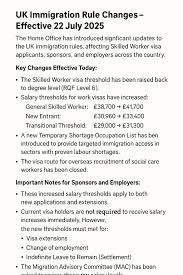UK Government Implements Sweeping Immigration Reforms in 2025: What You Need to Know

Introduction
The UK Government’s White Paper ‘Restoring Control over the Immigration System,’ presented to Parliament in May 2025, represents the most comprehensive overhaul of the UK’s legal migration framework in over a decade. The reforms aim to reduce migration, tighten visa eligibility, and integrate migration policy with broader labour market strategies.
Key Changes and Implementation
The new rules laid in Parliament introduce higher skills and salary thresholds, end overseas recruitment for care workers, and remove more than 100 occupations from the immigration system. These changes mark a fundamental shift in the UK’s approach to immigration, focusing on higher skills, lower numbers, and tighter controls, moving away from reliance on overseas, lower-skilled recruitment.
The minimum salary threshold has increased to £25,000 per year (£12.82 per hour) from the previous £23,200. While healthcare and education roles following national pay scales have updated thresholds aligned with the latest pay agreements, the new £25,000 floor applies universally to other occupations. This adjustment aligns Skilled Worker salaries with UK wage trends and keeps them above the National Living Wage.
Student and Settlement Changes
Significant changes affect the student visa route: only PhD students and researchers will be permitted to bring dependants, student sponsors must meet higher enrolment and course completion standards, and the Graduate Route is under review with potential new eligibility criteria, job offer requirements, or visa caps.
A major change to settlement rules will see the waiting period for indefinite leave to remain (ILR) increase from 5 to 10 years for most work visa holders. However, this change is not expected to affect family visas.
Future Implications
While many reforms will require legislative change and months to implement, the direction is clear. For individuals and sponsoring employers, these changes present significant legal and strategic considerations. Currently viable routes may soon close or become more restrictive, pathways to settlement will lengthen, and employers will face increased burden to demonstrate workforce strategies and investment in domestic talent.
These reforms are part of a broader programme of immigration and border security changes, with additional measures on asylum and border security expected to be announced later this year.









